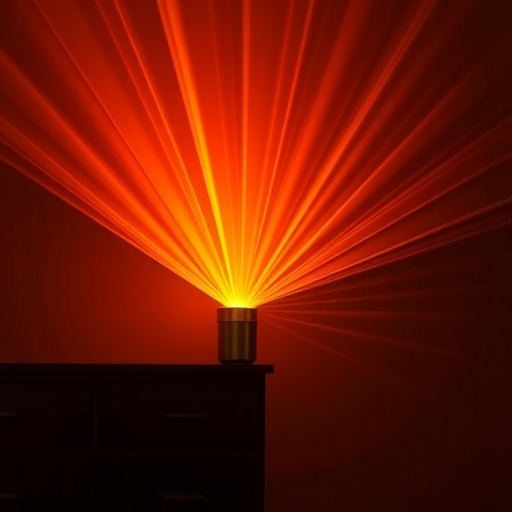A groundbreaking advancement in the amplification of ultrashort laser pulses has emerged, addressing one of the most persistent challenges in ultrafast optics: maximizing amplification bandwidth without sacrificing gain or efficiency. The research, published in Nature, reveals a novel multipass optical parametric amplification system that leverages state-of-the-art dispersion-engineered dielectric mirrors to surpass traditional limitations that have long constrained the field.
Ultrashort laser pulses, particularly those under 100 femtoseconds, exhibit inherently broad spectral bandwidths that complicate their amplification. Conventional amplification methods often face a trade-off: achieving broad bandwidth tends to reduce gain and efficiency, whereas methods with high gain typically narrow the amplification bandwidth. This intrinsic conflict has necessitated complex optical setups involving multiple preprocessing and postprocessing steps, significantly adding to the system’s complexity and cost.
Optical parametric amplification (OPA) stands out as a promising technique due to its potential for high gain that scales favorably with the nonlinear interaction length within the gain medium. However, conventional single-pass OPA is severely limited by the gain-bandwidth product; as gain increases over longer crystal lengths, bandwidth narrows, and nonlinear effects such as backconversion degrade the amplified pulses. These constraints render conventional OPA less effective for amplifying the extremely short and broadband pulses essential for cutting-edge applications.
The new approach designed by Nägele, Steinle, Thannheimer, and colleagues upends this status quo by employing a multipass architecture complemented by dispersion-engineered dielectric mirrors. These specialized coatings not only focus the laser repeatedly through the nonlinear crystal but also precisely compensate for group delay accumulated during each pass. Simultaneously, they suppress the idler wave, the byproduct of frequency conversion that can induce backconversion, thus preserving the energy transfer towards the signal wave.
This intricate engineering enables an unprecedented ×1,500 increase in gain compared to single-pass amplification setups, a quantum leap that significantly strengthens the amplified pulse without compromising its bandwidth. Impressively, the system attains a photon conversion efficiency of up to 81%, with an overall system efficiency of 52%, positioning this technology as a new benchmark for high-performance ultrafast laser amplifiers.
Crucially, the amplified output flirts with the Fourier limit, maintaining nearly transform-limited time–bandwidth products. This is an exceptional feat, as it preserves the intrinsic pulse characteristics vital for numerous precision-demanding applications. Moreover, the spatial beam quality remains pristine after amplification, assuring compatibility with sensitive downstream processes.
Breaking through what was previously perceived as an insurmountable barrier, the amplification system achieves a gain bandwidth product of 12 terahertz at 41 decibels of gain. This combination—a broad spectral bandwidth with extraordinarily high gain—was hitherto unattainable. Such performance heralds transformative implications across multiple domains reliant on ultrafast laser technology.
The versatility of this multipass OPA platform is augmented by its material-agnostic design. Unlike systems tailored to a narrow range of gain media, this concept extends its utility across diverse nonlinear crystals and laser configurations. This adaptability not only facilitates integration into existing ultrafast laser sources but also opens new frontiers in quantum information science, where high-gain, broadband ultrafast pulses are indispensable.
Applications span quantum technologies like quantum nondemolition measurements and Wigner function tomography, as well as attosecond physics—a field that scrutinizes phenomena unfolding on timescales shorter than a femtosecond. The ability to produce highly amplified, ultrabroadband pulses enhances the prospects for generating and manipulating attosecond light bursts, thereby accelerating discoveries in fundamental physics.
Beyond pure science, this innovation has practical implications for industrial and medical fields. Ultrabroadband, high-gain pulses can improve precision in material processing, offering unprecedented control over ultrafast material modifications. Furthermore, the technology promises to enrich ultrabroadband bio-imaging modalities, enabling deeper insights into biological tissues at reduced cost and with compact device footprints.
A notable hallmark of the presented system is its remarkably compact size. The entire multipass OPA setup fits within the low single-digit cubic centimeter range, a stark contrast to the sprawling configurations typically required for ultrafast pulse amplification. This miniaturization paves the way for portable, robust ultrafast laser sources deployable outside specialized laboratory environments.
Altogether, the dispersion-engineered multipass optical parametric amplifier is poised to redefine standard practices across ultrafast laser science and technology. By shattering the conventional gain-bandwidth trade-offs, this innovation enables dramatically improved performance without adding complexity, setting a new benchmark that will inspire extensive future research and commercialization efforts.
Researchers and industry leaders alike eagerly anticipate the ripple effects of this breakthrough. Whether it be in advancing quantum computing protocols, enhancing attosecond spectroscopy, or revolutionizing biomedical imaging, the implications of robust and efficient ultrashort pulse amplification are profound and far-reaching, promising to push the boundaries of what ultrafast laser technology can achieve.
This new paradigm demonstrates that the combined precision of dispersion engineering and ingenious multi-passing within nonlinear crystals can elevate ultrafast laser amplification to levels previously considered unattainable. As the technology matures and diffuses into diverse ultrafast applications, it is destined to become a cornerstone for the next generation of laser systems that demand both exceptional gain and bandwidth.
Subject of Research:
Ultrashort laser pulse amplification via dispersion-engineered multipass optical parametric amplification.
Article Title:
Dispersion-engineered multipass optical parametric amplification.
Article References:
Nägele, J.H., Steinle, T., Thannheimer, J. et al. Dispersion-engineered multipass optical parametric amplification. Nature 647, 74–79 (2025). https://doi.org/10.1038/s41586-025-09665-w
Image Credits:
AI Generated
DOI:
10.1038/s41586-025-09665-w
Keywords:
Ultrashort laser pulses, optical parametric amplification, dispersion engineering, nonlinear optics, broadband amplification, ultrafast lasers, femtosecond pulses, photon conversion efficiency, group delay compensation, multipass amplification, attosecond physics, quantum technologies




